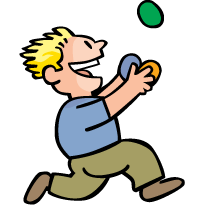Boston Children's Museum
308 Congress Street, Boston, MA 02210
617-426-6500
© Boston Children’s Museum 2025
Website Design by JackrabbitJuggling is not merely a fun activity, but it has many potential benefits as well. Juggling can help improve eye-hand coordination, problem-solving skills, ambidexterity, balance, motor skills, rhythm and timing—just to name a few. Research has even shown that people who learn how to juggle actually increase their brain size! In addition, self esteem, confidence, perseverance, teamwork and communication can reap the benefits of juggling, and children who learn best kinesthetically will really take to this activity.
Prepare the funnels – cut the bottles in half using a utility knife (or scissors if you don’t have a knife—but the knife is much easier). Be careful! Cutting plastic can be tricky, and once it’s cut, it tends to be sharp. You’ll be keeping the top sections of the cut bottles—notice how they look like funnels (See Figure 1)?
As a safety measure, place some duct tape around the cut end so the sharp plastic is not exposed.

Ask your students if anyone has juggled before. What does juggling look like? What do you usually juggle with? Does anyone know how to juggle? If you have a volunteer, have them show other kids what they can do (you’ll have to have a few juggling balls prepared to give them). You can also show them what you mean by juggling the balls yourself.
Make your own juggling balls and then learn how to juggle!
After 5–10 minutes, bring everyone together to talk about what they’ve done. Does anyone have any tips for the other children? What’s the hardest part of learning how to juggle? What’s the most fun part?
Have your kids practice some more. Do this activity every once in a while and watch their progress!